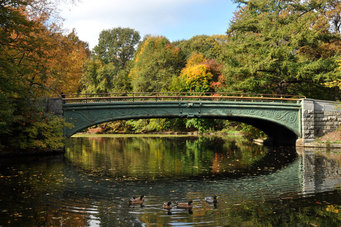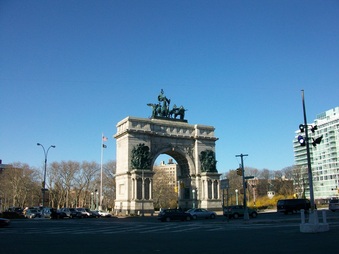Prospect Park - Brooklyn, NY
Prospect Park is one of the centerpieces of Brooklyn. It is a large public park that is strategically located within the borough, and has been an extremely valuable economic development catalyst for its surrounding neighborhoods. In an environment as dense as New York City, neighborhoods that are in close proximity to attractive and user-friendly public spaces are highly prized. As Brooklyn has become increasingly revitalized in recent decades, the neighborhoods directly adjacent to Park Slope and the park have experienced a dramatically positive economic turnaround. The attraction that is helping to pull people and investment to the area is a nearly 600 acre classic park that provides a valuable slice of nature that is comparable to a more wild version of Central Park. That comparison is not a coincidence, as Fredrick Law Olmsted is the mind and designer behind both parks that are now cultural and historic milestones for the city.
|
Prospect Park is a long ingrained cornerstone of Brooklyn life. The park has been open to the public since 1867, and has changed much in character and design since this initial date. A desire for the park grew directly from the successful development of Central Park, located a few miles away across the East River in Manhattan. A 585-acre oasis of natural beauty within the most densely urbanized region in America was the result of this desire. It is one of the prized masterpieces of the Olmsted park collection. The park itself is diverse, reflecting the extremely diverse character of Brooklyn and the neighborhoods that surround it. Olmsted designed the park to feature three distinct regions including a long open meadow, a heavily wooded ravine area, and a 60-acre lake. Originally imagined a place for rural retreat within city limits, its character and use has changed a bit over time. New additions to the original concept a zoo, playgrounds, public meeting spaces, and a bandshell, among others. Also, formalized entrances were later added to major park entrances. However, despite all of the activity, the park maintains an extremely natural and rural character (minus the crowds of people) throughout much of its interior. This is an invaluable asset to Brooklyn and New York City residents that exist in extremely dense and crowded environments.
|
However, as with much of New York City, the park experienced a period of decline in the latter half of the twentieth century. Popularity and overuse of facilities within the park led to declining conditions. This combined with a decrease in available funding to create an overall deterioration of facilities and conditions. As the neighborhoods surrounding the park changed and declined, the park followed suit. It was a similar trajectory to its sister in Manhattan, Central Park. However, the park enjoyed less funding and visitors than its celebrated sibling. By 1979, annual park visits had dropped to its lowest total in over 100 years. It became known as a dangerous place to avoid, which goes against all that it should stand for. An alteration in thinking had to occur and, by the 1980s, the NYC Parks Department entered into a partnership with Prospect Park Alliance, a non-profit organization, to manage and care for the park. The Alliance has been able to steadily increase private support and restoration of the park. Restoration efforts have been successfully implemented throughout many of the park's sectors. They have helped immensely to steer projects where the Parks Department have been unable to do so due to budget limitations and attention given to other city parks.
Prospect Park is now perhaps in a better condition than which it has ever been before. Brooklyn, New York City, and the park have all recently experienced a renaissance. The park is now safer and more popular than ever. It's surrounding neighborhoods are all on a consistent economic upswing. It is not a coincidence that they are within such close proximity to the grandest public space in all of Brooklyn. The park also serves as another prime example of the importance of public-private partnerships in maintenance and operation of valuable public spaces.
Prospect Park is now perhaps in a better condition than which it has ever been before. Brooklyn, New York City, and the park have all recently experienced a renaissance. The park is now safer and more popular than ever. It's surrounding neighborhoods are all on a consistent economic upswing. It is not a coincidence that they are within such close proximity to the grandest public space in all of Brooklyn. The park also serves as another prime example of the importance of public-private partnerships in maintenance and operation of valuable public spaces.



